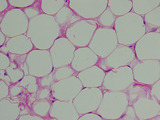
CT_adipose_kidney_400x, p000136
- Subject:
- Anatomy/Physiology
- Biology
- Health, Medicine and Nursing
- Material Type:
- Diagram/Illustration
- Author:
- Lauren Amundson
- Date Added:
- 07/25/2022

CT_adipose_kidney_400x, p000136
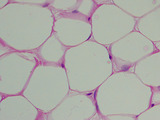
CT_adipose_kidney_630x, p000137

This resource is a video abstract of a research paper created by Research Square on behalf of its authors. It provides a synopsis that's easy to understand, and can be used to introduce the topics it covers to students, researchers, and the general public. The video's transcript is also provided in full, with a portion provided below for preview:
"For the first time, scientists have figured out how to grow and extend the life of primary airway epithelial cells from newborns and young children. These cells line our nasal passages and lungs, protecting us from pathogens, and controlling our immune responses to allergens. Differences in these cells may help explain why certain infants develop wheezing and asthma later in life, but studying them has been challenging because they are difficult to obtain in babies and usually die in culture after dividing a few times. Now, researchers at Children’s National Medical Center in Washington, D.C. and George Washington University have devised a way to reprogram pediatric airway epithelial cells so that they survive, creating a new model to study respiratory disorders that take hold early in life. The team collected airway epithelial cells from 23 donors, including newborns, infants and young children..."
The rest of the transcript, along with a link to the research itself, is available on the resource itself.

As taught Semesters 1 and 2, 2011
This learning object which is used as part of the level 1 Biological Sciences module delivered by the School of Nursing, Midwifery and Physiotherapy relates the microscopic appearance and structure of epithelia to their function.
Andy Meal, Lecturer in Biological Sciences, School of Nursing, Midwifery and Physiotherapy

This resource is a video abstract of a research paper created by Research Square on behalf of its authors. It provides a synopsis that's easy to understand, and can be used to introduce the topics it covers to students, researchers, and the general public. The video's transcript is also provided in full, with a portion provided below for preview:
"The intestinal epithelium constantly regenerates to maintain its barrier function, so intestinal stem cells (ISCs) are crucial to a healthy gut. Diet affects ISC activity both directly, by providing energy and metabolic substrates, and indirectly, by altering the gut microbiota, which can modulate inflammation and change epithelial structure. Gut microbes rely on dietary fiber as their main energy source, and specifically, soluble fiber is required for the production of microbiota-derived metabolites such as vitamins. Studies have shown benefits of soluble fiber consumption, but not all types of soluble fiber are well tolerated, and it's unclear which effects are direct (acting on ISCs) versus indirect (acting on the microbiota). To find out, researchers used mouse models, histochemistry, host-cell transcriptomics, and 16S microbiome analysis to examine the effects of the soluble fiber inulin on the gut..."
The rest of the transcript, along with a link to the research itself, is available on the resource itself.

This resource is a video abstract of a research paper created by Research Square on behalf of its authors. It provides a synopsis that's easy to understand, and can be used to introduce the topics it covers to students, researchers, and the general public. The video's transcript is also provided in full, with a portion provided below for preview:
"Gastric cancer is one of the highest mortality cancer types, and the leading cause of gastric cancer is persistent Helicobacter pylori infection. H. pylori secretes the enzyme HtrA, which cleaves adhesion proteins like E-cadherin and allows H. pylori to cross the epithelium. Recently, researchers used proteomics to find novel targets of HtrA associated with H. pylori. They confirmed E-cadherin as a target and identified human desmoglein-2 (hDsg2), neuropilin-1, ephrin-B2, and semaphorin-4D as potential targets. hDsg2 is a component of the desmosome junctions, which play important roles in epithelial cell-to-cell adhesion. Given the importance of cell-to-cell adhesion to epithelial health, the researchers focused on hDsg2. In vitro tests confirmed that HtrA secreted by H. pylori, and not other host cell proteases, cleaved hDsg2. This study is the first to demonstrate that HtrA secreted by H. pylori directly breaks down hDsg2 and suggests that HtrA is a ‘master key’ that allows H..."
The rest of the transcript, along with a link to the research itself, is available on the resource itself.
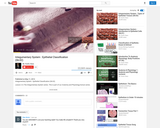
Our second video on epithelial tissues. This video focuses on epithelial classification.
The concepts covered in this video include:
•Epithelial Classification
•Squamous Epithelial
•Cuboidal Epithelial
•Columnar Epithelial
•Simply and Stratified Epithelial
•Pseudostratified
•Transitional Epithelium
Lesson 2 in The Integumentary System series. This is part of our Anatomy and Physiology lecture series.
If this video helps you please be sure to LST -like subscribe and tell your friends. Your support help us make more videos. For the complete series please visit http://mrfordsclass.net/
Videos in cell biology series:
- Introduction to Epithelial Cells (06:01): http://youtu.be/qdZ1U0LA1ko
- Epithelial Classification (06:02): http://youtu.be/HQDqb9yoHTE
- Types of Epithelial Tissues (06:03): http://youtu.be/KIZD56w_UAY

Anatomy and Physiology students must know some histology and there is no better place to start then by looking at the epithelial cells.
Lesson 1 in The Integumentary System series. This is part of our Anatomy and Physiology lecture series.
If this video helps you please be sure to LST -like subscribe and tell your friends. Your support help us make more videos. For the complete series please visit http://mrfordsclass.net/
Videos in cell biology series:
- Introduction to Epithelial Cells (06:01): http://youtu.be/qdZ1U0LA1ko
- Epithelial Classification (06:02): http://youtu.be/HQDqb9yoHTE
- Types of Epithelial Tissues (06:03): http://youtu.be/KIZD56w_UAY
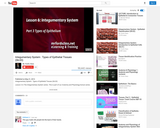
In this video we look at the types of epithelial tissues. In the previous video we saw how to classify them, this video examines their structures and functions.
Lesson 3 in The Integumentary System series. This is part of our Anatomy and Physiology lecture series.
If this video helps you please be sure to LST -like subscribe and tell your friends. Your support help us make more videos. For the complete series please visit http://mrfordsclass.net/
Videos in cell biology series:
- Introduction to Epithelial Cells (06:01): http://youtu.be/qdZ1U0LA1ko
- Epithelial Classification (06:02): http://youtu.be/HQDqb9yoHTE
- Types of Epithelial Tissues (06:03): http://youtu.be/KIZD56w_UAY

Kidney glomerulus with juxtaglomerular apparatus_630x, p000134
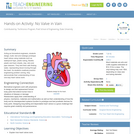
Acting as biomedical engineers, students design, build, test and redesign prototype heart valves using materials such as waterproof tape, plastic tubing, flexible plastic and foam sheets, clay, wire and pipe cleaners. They test them with flowing water, representing blood moving through the heart. As students creatively practice engineering problem solving, they demonstrate their understanding of how one-way heart valves work.
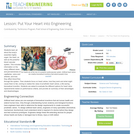
This lesson contains background about the blood vascular system and the heart. Also, the different sizes of capillaries, veins, and arteries, and how they affect blood flow through the system. We will then proceed to talk about the heart's function in the blood vascular system. This will lead into a discussion of heart valves, how they work and what might cause them to fail. Then we will discuss prosthetic heart valves.

As taught Semesters 1 and 2, 2011
This learning object describes the structure and function of epithelia. This learning object is used as part of the level 1 Biological Sciences module delivered by the School of Nursing, Midwifery and Physiotherapy.
Dr Andy Meal, Lecturer in Biological Sciences, School of Nursing, Midwifery and Physiotherapy

This resource is a video abstract of a research paper created by Research Square on behalf of its authors. It provides a synopsis that's easy to understand, and can be used to introduce the topics it covers to students, researchers, and the general public. The video's transcript is also provided in full, with a portion provided below for preview:
"Undernourishment or undernutrition can be caused by a lack of food or a high energy demand, such as during pregnancy and lactation. Undernutrition in production animals disrupts metabolic homeostasis and causes serious health problems, including maternal metabolic disorders and stillbirth. Many production animals are ruminants, named for their unique digestive organ, the rumen, which houses a diverse anaerobic microbiome. The ruminal microbiome allows the host to break down hard-to-digest plant carbohydrates and produce protein that the host later absorbs. But little is known about the effects of undernutrition on the host-microbiome interaction in ruminants. A recent study investigated changes in the ruminal microbiome and epithelium in undernourished pregnant sheep. During undernutrition, the bacterial genes involved in the digestion of carbohydrates and protein synthesis were downregulated. This meant less energy and protein was available to the host and critical signaling pathways were inhibited..."
The rest of the transcript, along with a link to the research itself, is available on the resource itself.

This resource is a video abstract of a research paper created by Research Square on behalf of its authors. It provides a synopsis that's easy to understand, and can be used to introduce the topics it covers to students, researchers, and the general public. The video's transcript is also provided in full, with a portion provided below for preview:
"Chronic rhinosinusitis is one of the most common diseases among humans, affecting approximately 12% of the adult population globally. It is characterized by inflammation of the nasal cavity and sinuses, causing facial pressure and pain as well as long-term loss of smell. Benign masses called nasal polyps can also develop and cause chronic nasal obstruction, but the exact cause of this disease is unknown. Recent research has indicated that toxins produced by the bacterium _Staphylococcus aureus_, particularly enterotoxin B (SEB), may play an important role. SEB is thought to stimulate the immune system by activating proteins such as toll-like receptor 2 and pro-inflammatory cytokines and by causing reactive oxygen species production and endoplasmic reticulum stress. This inflammatory response may then disrupt the integrity of the epithelial cells in the nose and sinuses..."
The rest of the transcript, along with a link to the research itself, is available on the resource itself.

simple columnar epi with goblet cells_intestine_400x, p000138
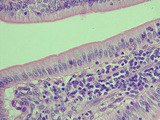
simple columnar epi with goblet cells_intestine_630x, p000139
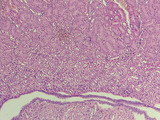
simple cuboidal epi_in kidney tubules_100x
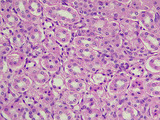
simple cuboidal epi_in kidney tubules_400x
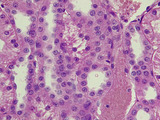
simple cuboidal epi_in kidney tubules_630x, p000133